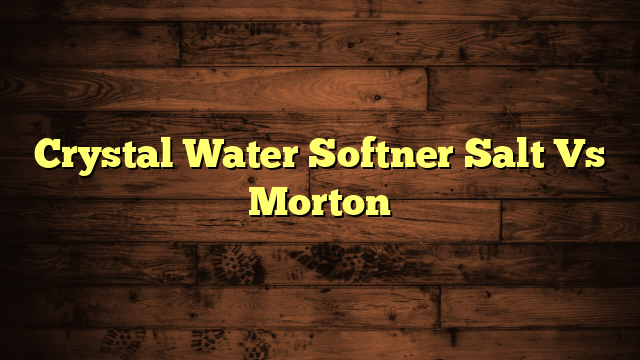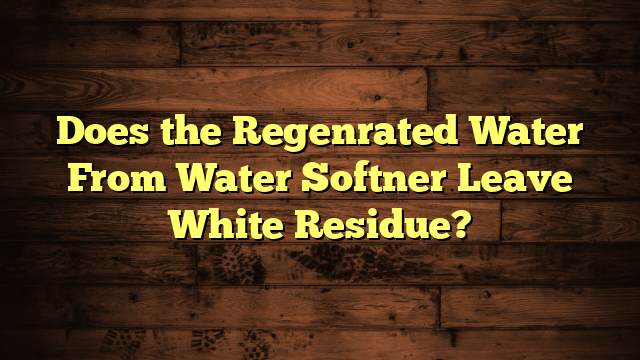Why Is My Water Softner Draining?
If your water softener's draining more than usual, you might be wondering what's causing the issue. It could be due to a range of factors, such as water hardness, regeneration cycles, or even excessive water usage. Each of these elements plays a crucial role in how well your system functions. However, before you jump to conclusions, it's important to consider some less obvious culprits that might be impacting your softener's performance. Understanding these nuances could lead you to a solution you didn't expect.
Key Takeaways
- High water hardness can exceed the softener's capacity, causing excessive drainage as the system struggles to process the water effectively.
- Improper regeneration or failure to regenerate the system can lead to overflow of brine water, resulting in unnecessary drainage.
- Excessive water usage, particularly during peak periods, can strain the system and lead to increased drainage cycles.
- Clogged drain lines can restrict water flow, causing backups and improper draining within the water softener system.
- Malfunctioning valves, such as control or brine valves, may wear out and cause drainage issues if not regularly maintained.
Common Reasons for Draining
Several factors can cause your water softener to drain unexpectedly. One common reason is water hardness. If the hardness of your water exceeds the softener's capacity, it may struggle to process the excess minerals, leading to drainage issues.
You might notice that your water softener isn't regenerating properly, which can trigger an overflow of brine water.
Different softener types also play a role. For instance, ion exchange softeners require regular monitoring and maintenance to function efficiently. If you're using a newer model, check if it has any error messages or alerts indicating a malfunction.
Additionally, older models may develop wear and tear, affecting their drainage systems.
Another reason could be improper installation. If your softener isn't connected correctly, it may lead to leaks or excess drainage. It's crucial to ensure that all connections are secure and that the unit is level.
You should also inspect the drain line for any blockages or kinks. By addressing these common issues, you can prevent your water softener from draining unexpectedly and ensure it operates effectively.
Salt Bridges and Their Impact
In your water softener, a salt bridge can create significant issues if left unaddressed. This occurs when the salt in the brine tank forms a solid mass, preventing the water from effectively dissolving the salt.
When this salt bridge formation happens, your softener may not regenerate properly, leading to inadequate softening and, ultimately, the system draining unexpectedly.
To troubleshoot salt bridges, start by checking the brine tank. If you notice a hard crust or a compact layer of salt, that's a telltale sign.
You can break the bridge by gently tapping around the edges of the salt mass with a broom handle or similar tool. After breaking it apart, make sure to add water to the tank to help dissolve the remaining salt.
Regularly inspecting your brine tank and keeping an eye on salt levels can prevent this issue.
If you notice recurring salt bridge formation, consider adjusting your salt type or changing your refill schedule.
Addressing salt bridges promptly will help maintain your water softener's efficiency and prevent unnecessary draining problems.
System Overload Issues
System overload issues can arise when your water softener is overwhelmed by the volume of water it needs to process. This often happens if your household's water usage exceeds the system capacity. When there's too much demand, it can cause the softener to drain excessively, leading to inefficiencies and potential damage.
Here's a quick reference table to help you understand the impact of system overload:
| Factor | Impact |
|---|---|
| High Water Usage | Exceeds system capacity |
| Low Water Pressure | Inhibits proper softening |
| Frequent Regeneration | Increases drain cycles |
| Extended Usage Spikes | Strains the system |
If you notice that your water softener is draining more often than usual, check your water pressure and usage patterns. High water pressure can exacerbate the issue, forcing the system to work harder. Consider adjusting your water consumption habits or upgrading to a unit with a higher capacity to better meet your needs. By addressing these factors, you can help prevent overload issues and keep your water softener functioning smoothly.
Clogged Drain Lines
If your water softener's draining unexpectedly, clogged drain lines could be the culprit.
A blocked drainage pipe or improper installation might be restricting water flow.
It's essential to check these issues to restore your system's functionality.
Blocked Drainage Pipe
A blocked drainage pipe can be a frustrating issue for any homeowner relying on a water softener. When your drainage lines are clogged, water can't flow freely, causing the system to back up and drain improperly. This not only reduces the efficiency of your water softener but can also lead to more significant plumbing problems down the line.
To tackle this issue, start with regular pipe maintenance. Inspect your drainage lines for visible blockages or signs of buildup. If you notice any issues, consider using a plumbing snake or a high-pressure water jet to clear the blockage.
Additionally, you might want to explore different drainage solutions, such as installing a filter or strainer in your drain lines to prevent debris from accumulating.
If you're unsure about how to proceed, don't hesitate to call a professional plumber. They can provide expert advice and ensure that your drainage system is functioning correctly.
Staying proactive with your pipe maintenance will save you time, money, and the hassle of dealing with a blocked drainage pipe in the future. Remember, a little attention now can prevent bigger problems later on!
Improper Installation Issues
When you install a water softener, ensuring proper setup is crucial for its optimal performance. One common issue you might encounter is clogged drain lines, often resulting from improper installation. If the drain lines are not positioned correctly, water can back up, causing your softener to drain continuously.
Here's a quick reference table that outlines potential installation issues and their solutions:
| Issue | Solution |
|---|---|
| Incorrect Drain Line Position | Reposition according to installation guidelines. |
| Kinks in the Drain Line | Inspect for bends and straighten them out. |
| Improper Slope | Ensure that the drain line has a proper slope for efficient flow. |
| Blocked Drain Connection | Clear any debris or obstructions in the drain line. |
Malfunctioning Valves
Malfunctioning valves can be a significant culprit behind your water softener's drainage issues. If you notice your system draining unexpectedly, it's worth inspecting the various valve types in your unit.
There are several types of valves in water softeners, including control valves, bypass valves, and brine valves, each playing a crucial role in the system's operation.
Over time, these valves can wear out, get stuck, or become clogged, leading to improper functioning. Regular valve maintenance is essential to keep everything running smoothly.
Check for any visible signs of wear, such as cracks or corrosion, and ensure that all seals are intact.
If you find that a valve isn't operating correctly, you might need to clean or replace it. Regularly exercising the valves can help prevent sticking, and lubricating them with appropriate products can keep them in good shape.
Don't overlook these critical components, as they're essential for maintaining the efficiency of your water softener.
Excessive Water Usage
If you notice your water softener draining more than usual, it might be due to increased household consumption.
Check for any leaks or malfunctions that could be causing excess water usage.
Addressing these issues can help reduce unnecessary draining and improve efficiency.
Increased Household Consumption
Excessive water usage in your home can significantly impact your water softener's performance, causing it to drain more frequently.
When your household habits lead to higher water demand, your softener works overtime to keep up, which can result in increased drainage and possibly even premature wear.
Here are some common reasons for increased household consumption:
- Longer Showers: Spending extra time in the shower can add up quickly, straining your water supply.
- Frequent Laundry Loads: Washing clothes too often or using a high water setting can contribute significantly to your total usage.
- Overwatering Plants: If you're watering your garden excessively, you mightn't realize how much water you're really using.
Keeping an eye on your daily habits can help you manage your water demand.
By being mindful of how much water you use for cooking, cleaning, and personal care, you can reduce the strain on your water softener.
This not only helps your softener function better but can also save you money on your water bill.
Leaks and Malfunctions
While you mightn't immediately notice, leaks and malfunctions in your water softener can lead to significant water waste and increased drainage. If you suspect something's off, it's crucial to focus on leak detection. Small leaks can often go unnoticed, but they gradually add up, causing your system to drain more than it should.
Component wear is another issue to consider. Over time, parts like seals and valves can deteriorate, resulting in inefficiencies and leaks. If you see water pooling around your softener or hear unusual sounds, these are signs that something may be wrong.
Regular maintenance is essential to prevent excessive water usage. Check for any visible signs of wear and tear, and don't hesitate to consult a professional if you're unsure.
Maintenance Tips to Consider
Regular maintenance is crucial for keeping your water softener functioning properly and preventing unnecessary drainage issues.
By performing preventive maintenance and scheduling regular inspections, you can catch potential problems before they escalate. Here are some tips to consider for effective upkeep:
- Check Salt Levels: Ensure the salt level in your brine tank is adequate. Low salt can lead to inefficient softening and increased drainage.
- Clean the Brine Tank: Periodically clean the brine tank to remove any salt bridges or sludge buildup that can interfere with operation.
- Inspect Hoses and Connections: Examine all hoses and connections for leaks or wear. Replacing damaged parts promptly can prevent drainage problems.
Frequently Asked Questions
Can a Water Softener Drain Without Any Visible Issues?
Yes, a water softener can drain without visible issues. During regular water softener maintenance, check for hidden leaks that might not be immediately apparent, as they can lead to unnoticed drainage problems over time.
How Often Should I Check My Water Softener for Problems?
You should check your water softener regularly, ideally every six months. Establish a maintenance schedule for routine inspections to catch potential problems early and ensure your system runs efficiently, saving you time and money in the long run.
Is My Water Softener Too Old to Function Properly?
Your water softener's lifespan typically ranges from 10 to 15 years. If you notice signs of malfunction, like inconsistent water quality or unusual noises, it might be time to consider replacement or professional evaluation.
What Should I Do if My Water Softener Is Leaking?
If your water softener's leaking, start with leak detection to identify the source. Then, explore repair options like tightening fittings or replacing damaged parts. Don't hesitate to consult a professional for more complex issues.
Can Hard Water Damage My Water Softener Over Time?
Yes, hard water can negatively impact your softener's lifespan. The hard water effects, like scale buildup, can reduce efficiency and lead to more frequent repairs. Regular maintenance helps mitigate these issues and prolongs your softener's life.
Conclusion
In conclusion, if your water softener's draining excessively, it's essential to troubleshoot the common issues like salt bridges, system overload, or clogged drain lines. Regular maintenance can prevent these problems and keep your system running smoothly. By addressing excessive water usage and checking for malfunctioning valves, you can enhance your water softener's efficiency. Stay proactive with inspections, and you'll ensure your water softener performs at its best for years to come.







